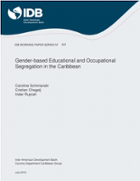Gender-based Educational and Occupational Segregation in the Caribbean
Date
Jul 2018
This study analyzes the evolution of gender-based educational and occupational segregation, from 1999 to 2016, for four Caribbean countries (The Bahamas, Barbados, Jamaica, and Trinidad and Tobago). The focus is on the role of educational segregation in explaining occupational segregation. There are four major findings. First, aggregate gender–based educational and occupational segregation have remained almost constant over time at approximately 7.5 percent and 18.5 percent, respectively. This is observed despite working women’s education levels increasingly exceeding those of working men and significant differences in female labor force participation across countries. Educational segregation ranges from 9 percent in Trinidad and Tobago to 4 percent in The Bahamas. Second, a disaggregated analysis by educational and occupation categories shows highly segregated labor markets. Educational segregation is rising in all countries at the university level in favor of women. In all countries, over 22 percent of employed younger women obtain university education compared to a stagnant to decreasing share of men. Of the university degree–holding employees, over 60 percent are women. Men strongly dominate agricultural occupations, plant and machine operators, and crafts–related jobs, while women dominate clerical positions to a similar extent. Third, for these highly segregated occupations, educational segregation is the main driver. Top and lower–end positions seem to be the least segregated in all countries. This distinction is particularly stark in The Bahamas and Barbados, but rising for the other two countries. Fourth, counterfactual analysis indicates that low segregation levels at the lowest occupational category are not necessarily justified, as older women are highly over represented in elementary occupations.



